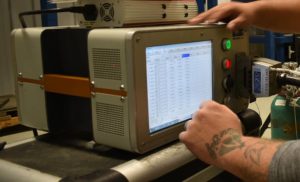
An Industrial Service Company offering a unique blend of services
1-855-227-5510
Email: [email protected]
XCEL
2755 State Hwy 322, Longview, TX 75603 | Mailing PO Box 8024, Longview, TX 75607
Carbon Equivalent (CE) takes Positive Material Identification (PMI) a degree further. PMI testing delivers composition of metals and alloys. However, carbon equivalency is the process of taking the information from these compositions and inserting them into a mathematical formula which will in turn help determine the weldability of the tested items.
Higher concentrations of carbon and other alloying elements such as silicon, manganese, chromium, copper, molybdenum, vanadium, and nickel tend to increase hardness and decrease weldability. However, each of these elements influence both the hardness and weldability of the steel in different magnitudes. This is why the formula was created to help determine a more universal system in determining which materials are more suitable to be welded on than others.
The Carbon Equivalency formula utilizes Optical Emission Spectroscopy (OES) analysis and Laser Induced Breakdown Spectroscopy (LIBS). The percentages of material make up can be recorded and input into the CE formula.
Carbon Equivalent application includes:
-
Determine whether the carbon, chromium, and nickel thinning in pressure vessel overlays are within the specified range for optimized corrosion resistance
-
Evaluate the carbon equivalency of an old part to be re-welded. Reliable results allow clients to make important repair decisions
-
Ensure that the correct grade of an alloy has been inserted into a certain equipment circuit in petrochemical plants and refineries
-
Double check that mass-produced part batches did not get mixed up with other batches
-
For semi-quantitative analysis to provide information regarding the concentrations of specific elements in a metal sample
-
For grade identification to: Determine the concentrations of elements in an alloy; Identify whether or not the tested sample meets the user specified grade
Carbon Equivalency advantages:
-
Quick inspection with fast accurate results
-
Measures a wide range of elements, particularly carbon, and concentrations in many different materials.
-
Extremely accurate when measuring low levels of trace and tramp elements
Carbon Equivalency limitations:
-
Testing area must have an overall thickness greater than 0.5 mm
-
Tests must be performed within specific temperature ranges to confirm accuracy of the analysis and the integrity of the equipment
-
Magnetized samples should not be analyzed because they will cause disruptions to the arc
-
Surface must be clean of all foreign material